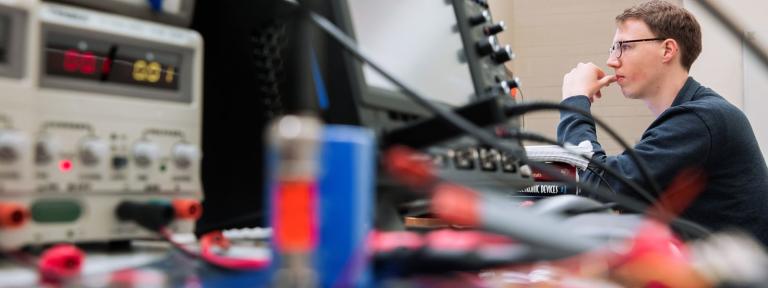
When Kenneth Kaiser, associate professor in the Electrical and Computer Engineering Dept., arrived at Kettering University in 1990, he had several professional goals. One was to energize his classroom using classical topics in Electrical Engineering. This goal is in his words, "Ongoing." Another goal was to write a reference and textbook that is different than others and encompassed several different fields in Electrical Engineering. After a decade of work, he recently completed this goal. CRC Press (www.crcpress.com) brought out his 2,500-page book titled "Electromagnetic Compatibility Handbook" in September 2004 and Kaiser believes it is the largest single volume, single author book ever published.
The book is comprised of hundreds of approximations, guidelines, models and standard rules used in electromagnetic compatibility (EMC) analysis and complete with sources and limitations. Although the main emphasis of the book is on the important field of electromagnetic compatibility, Kaiser interweaves classical topics in electromagnetics, advanced circuits, and signals and systems into the text.
"Electromagnetic compatibility exists when the electromagnetic fields, which are generated by any product or device with time-varying current, exist together in harmony," Kaiser explained. In some cases when products are not electromagnetically compatible, the consequence is merely annoying, such as when the noise generated by a vacuum cleaner interferes with the reception of a reality show on a nearby television. In other applications, however, incompatibility can be costly or even dangerous. An example of this is the sporadic malfunctioning of an engine control module in an automobile from a cellular phone, which could be very costly for the automotive maker, Kaiser said. As the number of electrical products in use continues to grow, so do the challenges of ensuring the electromagnetic compatibility of products and systems.
Kaiser's interest in this field and electrical engineering in general began in high school with his involvement in amateur radio. At that time, he was "overwhelmed by the number of approximations that were used in EMC," he said. But he was also fascinated by their simplicity compared to their more exact counterparts in classical electromagnetic theory.
Many of the examples and explanations contained in his book were initially written for personal documentation purposes and for further reference and edification as he sought to answer many questions he had. These problems and notes eventually became the seed for new class exercises. He wrote his text using the Socratic question and answer style, which is considered unorthodox in contemporary engineering texts, but helpful to students who appreciate the direct approach and quick overview of material.
Kaiser devoted extensive hours in crafting the hundreds of tables in the book, which he hopes will have lasting value in many different disciplines in Electrical Engineering. He noted that books of this size and scope are frequently written by multiple experts. As a single author of this text, Kaiser feels he has created a handbook with a consistent style and nomenclature, and feels fully responsible for the entire book and its accuracy, including the 2,300 tables and figures. To insure accuracy of content, he derived or checked nearly every expression in this book. In addition, to reduce the cost of the final book for students and increase the quality of the text, he drew each figure and typeset each of the thousands of equations himself.
"Many superb students have carefully reviewed various versions of the manuscript, locating errors and making valuable suggestions," he said. Kaiser appreciates the invaluable help of his students and colleagues. He noted that Dr. James McLauglin of the Electrical Engineering Dept. was of particular help by offering many contributions and continual encouragement during the development of the book. "Not only did he devote hundreds of hours as both the technical and style editor, carefully reviewing the manuscript, a Herculean task in itself, but he provided so many wonderful, scholarly, and invaluable insights contained throughout this book," Kaiser said.
To learn more about "Electromagnetic Compatibility Handbook," contact Dr. Ken Kaiser at (810) 762-7989, or at his web site www.klkaiser.com.
Written by Gary Erwin
810-762-9538
gerwin@kettering.edu